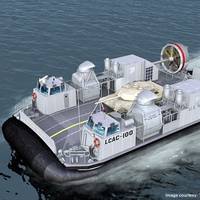Updates, Developments and Advances in Combat and Patrol Craft

My first visit in 2007 to the American Society of Naval Engineers’ (ASNE) Multi-Agency Craft Conference (MACC) was an eye-opener. Having built a naval architecture career with frigates, destroyers and other large naval and commercial ships, I was eager to learn of the smaller craft used by the U.S. Navy and other government and military bodies. As my flight into Norfolk, Va. descended over Chesapeake Bay, I gazed in amazement as a Landing Craft Air Cushion (LCAC) raced toward Virginia Beach, slowed, glided up the beach and into its shore base.
Textron Choose IBASEt Manufacturing Software
iBASEt, developers of Solumina’s Product Lifecycle Execution (PLE) software suite say that Textron Systems operating unit Textron Marine & Land Systems, has selected Solumina’s Manufacturing Execution System (MES) to streamline manufacturing operations for its work on the U.S. Navy’s Ship to Shore Connector (SSC) air cushion vehicle. IBASEt inform that the SSC is the evolutionary replacement for the Navy’s existing fleet of Landing Craft, Air Cushioned (LCAC) vehicles, which are nearing the end of their service life. Since Solumina captures all the manufacturing data during the entire product’s manufacturing lifecycle, detailed manufacturing intelligence is easily accessible through dashboards, graphs and reports at the click of a button.
Rolls-Royce to Power USN Hovercrafts

Rolls-Royce wins contract to power the U.S. Navy’s future fleet of hovercrafts, known as the Ship-to-Shore Connector (SSC). The Group will work with Textron Marine & Land Systems, an operating unit of Textron Systems, a Textron Inc. company, which has been selected to build the initial development craft, in a program that could extend to 73 craft. The SSC will replace the Navy’s current fleet of Landing Craft Air Cushion (LCAC) hovercraft over the next 20 years. The new hovercraft will be used to rapidly deploy personnel and vehicles between U.S. Navy ships and the shore.
Unmanned Surface Vessel – Second by Textron Systems
Textron Systems Advanced Systems, an operating unit of Textron Systems, a Textron Inc. company, announce that its second Fleet-class Common Unmanned Surface Vessel (CUSV) completed a successful in-water demonstration in New Orleans following vessel modifications at the Textron Marine & Land Systems (TM&LS) shipyard. The two Textron Systems operating units recently collaborated on vessel performance enhancements and are preparing to participate in additional capabilities demonstrations for the United States Navy. The team also is pursuing vessel contracts with the U.S. Navy, international navies and other government agencies in the U.S. and overseas.
U.S. Navy: The Business Case for a Titanium Ship

Participants at a workshop exploring the use of titanium structure for ships found that it is not only possible to construct a ship hull from titanium—or Ti, it could be cost effective. The workshop was sponsored by the Office of Naval Research and hosted by the University of New Orleans, where an ONR research program on titanium ship structures is being conducted. Representatives of the shipbuilding industry, titanium suppliers, Navy, Coast Guard and Air Force labs, and academia discussed and examined materials, processes and applications. Most ships today are primarily made from steel.
Companies Team on Ship-to-Shore Connector
Textron Marine & Land Systems, an operating unit of Textron Systems, a Textron Inc. (NYSE: TXT) company, has teamed with L-3 Communications (NYSE: LLL) to pursue the Navy’s next generation landing-craft, the Ship-to-Shore Connector (SSC), and to further develop the Navy’s contract design using its proven detailed design-to-prototype build practices. The SSC program, estimated by the Navy to have a value of $4b, provides for the construction of up to 80 hovercraft to replace the aging Landing Craft Air Cushion (LCAC) fleet. These craft provide the primary over-the-horizon, ship-to-objective amphibious lift capability, as well as the capability to move across the beach carrying heavy payloads for military and humanitarian operations.
LCAC 25 Gets a Turnover
reached a major production milestone -- the hull turnover -- at Textron Marine & Land Systems (TM&LS) in New Orleans, La. on May 2, 2002. TM&LS, the current Navy prime contractor, hosted the hull turnover ceremony at its main LCAC production facility to mark the completion of the hull assembly line process and the beginning of the craft assembly station process. or "deep," skirt system to contain the cushion of air it rides on, enhanced engines, and new communications and navigation systems. service life will be extended from 20 to 30 years. Marine Air/Ground Task Force. The craft have the ability to operate independently of tides, water depth, underwater obstacles, or beach gradients.
Additional Rescue Craft to be Built
Textron Marine & Land Systems has announced the award of the third-year option for the construction of 23 47-ft. motor lifeboats for the USCG. The contract, valued at approximately $20 million, includes associated training, spares and other support services. The recent award brings the total number of boats awarded to the company to 93. The total possible contract value, with all options, approximates $165 million. Construction of these 23 vessels will begin immediately to take full advantage of the production line already in progress. The new vessel significantly enhances the USCG's ability to perform search and rescue operations in heavy weather conditions. The boat design incorporates technological innovations, including a lightweight but rugged aluminum hull can withstand 20-ft.
USCG Receives Motor Lifeboat
USCG Station Shinnecock, in Hampton Bays, N.Y., received a new state-of-the-art 47 ft. motor lifeboat (MLB), which will replace the 44-ft. MLB as part of the USCG's Office of Shore Activities MLB Replacement Project. Built by Textron Marine & Land Systems to USCG specifications, the 47 ft. MLB is capable of operating in 20-ft. breaking surf, 30-ft. open seas and 50-knot sustained wind speed. Similar to the 44-ft. MLB, the 47-ft. MLB will re-right itself within eight seconds in the event of a capsizing. The vessel is expected to perform the USCG missions of search and rescue, law enforcement and marine environmental protection for the next 25 years.






